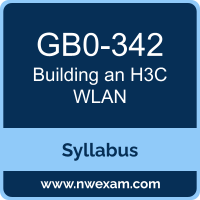 A great way to start the H3C Certified Senior Engineer For WLAN (H3CSE-WLAN) preparation is to begin by properly appreciating the role that syllabus and study guide play in the H3C GB0-342 certification exam. This study guide is an instrument to get you on the same page with H3C and understand the nature of the Building an H3C WLAN exam.
A great way to start the H3C Certified Senior Engineer For WLAN (H3CSE-WLAN) preparation is to begin by properly appreciating the role that syllabus and study guide play in the H3C GB0-342 certification exam. This study guide is an instrument to get you on the same page with H3C and understand the nature of the Building an H3C WLAN exam.
Our team of experts has composed this H3C GB0-342 exam preparation guide to provide the overview about Building an H3C WLAN exam, study material, sample questions, practice exam and ways to interpret the exam objectives to help you assess your readiness for the H3C H3CSE-WLAN exam by identifying prerequisite areas of knowledge. We recommend you to refer the simulation questions and practice test listed in this guide to determine what type of questions will be asked and the level of difficulty that could be tested in the Building an H3C WLAN certification exam.
H3C GB0-342 Exam Overview:
|
Exam Name
|
Building an H3C WLAN |
| Exam Number | GB0-342 H3CSE-WLAN |
| Exam Price | $165 USD |
| Duration | 60 minutes |
| Number of Questions | 50 |
| Passing Score | 600/1000 |
| Recommended Training | Building an H3C WLAN |
| Exam Registration | PROMETRIC |
| Sample Questions | H3C GB0-342 Sample Questions |
| Practice Exam | H3C Certified Senior Engineer For WLAN (H3CSE-WLAN) Practice Test |
H3C GB0-342 Exam Topics:
| Section | Objectives |
|---|---|
| Wireless Technology System and Theory |
- Background Knowledge of the WLAN Technology: WLAN characteristics, related organizations and standards, development process and major technical indicators of 802.11, and basic concepts (SSID, BSS, and ESS) of 802.11 networks. - Fundamentals of Wireless Technologies: relevant properties of electromagnetic waves, conversion between power calculation units, modulation transmission mode of the WLAN, and propagation characteristics of radio waves - IEEE 802.11 protocol suite: 802.11 protocol suite members and protocol standards, working principle of the MAC layer, WEP encryption, wireless security 802.11i (WPA and WPA-PSK), wireless QoS technologies such as 802.11e, 802.11n, and 802.11ac - Introduction to major WLAN equipment: principles and characteristics of Fat APs, principles and characteristics of wireless bridges, working principles and data forwarding flow of wireless controller + Fit AP, principles of antennas, and major parameters - Typical deployment methods of WLAN: Fat AP, bridge, wireless controller + Fit AP |
| H3C Wireless Product Features and Configuration |
- Basic functions and configuration of H3C Fat APs: default configurations and common commands (channel, power, SSID, authentication, and encryption) of Fat APs - Advanced features and configurations of H3C Fat APs: user rate limit, wireless bridging, wireless access control, and limitations on the number of users - H3C wireless controller + Fit AP series: product features and main specifications - Basic configurations of H3C wireless controller + Fit AP: default configurations and common commands of the wireless controller + Fit AP - Advanced features and configurations of the H3C wireless switch + Fit AP: wireless air interface rate limit, WLAN user roaming, WLAN user isolation, wireless controller backup, and wireless security authentication |
| WLAN Survey and Design |
- WLAN Survey Operation Guide: significance and process of WLAN survey, WLAN signal propagation model and path loss, survey preparations, use of common software and hardware toolkits, and survey output - WLAN indoor coverage survey design: indoor coverage design principles, signal attenuation models, typical indoor coverage application models, and indoor survey techniques - WLAN outdoor coverage survey design: outdoor coverage design principles, and typical outdoor coverage applications - Combination design of the indoor distribution system: WLAN combination system design principles, common components of the combination system, and typical scene design of the combination system |
| WLAN Solutions |
- WLAN solutions for rail transport: basic principles of rail transport, train-to-ground communication system, and rail transport data transmission - WLAN solutions for the medical industry: X-Share, indoor installation, and indoor power division - Wireless positioning application solutions: triangulation, fingerprint positioning, and cupid positioning |
| WLAN Product O&M Instructions |
- Engineering installation instructions of WLAN products: component mounting of WLAN products, typical indoor installation procedures and installation methods, typical installation procedures and installation methods - Engineering implementation specifications of WLAN products: engineering installation specifications and precautions of WLAN products |
| Wireless Product Troubleshooting and Management |
- Knowledge and skills required for WLAN maintenance personnel: basic data communication knowledge and WLAN basics - Basic content of WLAN product maintenance: content of daily maintenance and common problem handling - Basic configurations and maintenance of the H3C wireless network management: topology discovery, view, performance monitoring, and alarm management of the iMC WSM - WLAN product maintenance precautions: engineering norms and interference source identification - Problem identification and processing methods of WLAN equipment: installation incompliance, configuration issues, and interference issues - Common operations and troubleshooting methods of STA access |
| WLAN Optimization Introduction |
- Operation process of WLAN optimization projects: delivery mode and operation process of WLAN optimization services - General instructions on WLAN optimization project delivery: delivery preparations, delivery process, and acceptance criteria |
H3C H3CSE-WLAN Exam Description:
H3C Certified Senior Engineer For WLAN (H3CSE-WLAN) Certification will help you understand the 802.11 protocol suite, further master WLAN surveying and design utilizing mainstream WLAN devices and antennas, and prepare you for using H3C wireless products in deployment, engineering implementation, and O&M situations.
